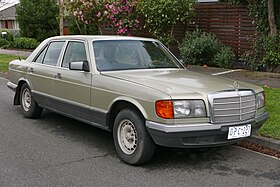Mercedes-Benz W126
| Mercedes-Benz W126 | |
|---|---|
 |
|
| Overview | |
| Manufacturer | Mercedes-Benz (Daimler-Benz) |
| Production |
|
| Assembly | Germany: Sindelfingen Malaysia: Johor Bahru (OASB) South Africa: East London |
| Designer | Bruno Sacco (1975, 1976) |
| Body and chassis | |
| Class |
Full-size luxury car (F) Grand tourer (C126) |
| Body style | 4-door sedan 2-door coupé (C126) |
| Layout | FR layout |
| Powertrain | |
| Engine |
Straight-5 3.0 L OM617 diesel Straight-6 2.6 L M103 2.8 L M110 3.0 L M103 3.0 L OM603 diesel 3.5 L OM603 diesel V8 3.8 L M116 4.2 L M116 5.0 L M117 5.5 L M117 |
| Transmission | 4-speed 4G-TRONIC automatic 4-speed manual 5-speed manual |
| Dimensions | |
| Wheelbase | Sedan (SWB): 2,935 mm (115.6 in) Sedan (LWB): 3,075 mm (121.1 in) Coupe: 2,850 mm (112.2 in) |
| Length | Sedan (SWB): 4,995–5,020 mm (196.7–197.6 in) Sedan (LWB): 5,135–5,160 mm (202.2–203.1 in) Coupe: 4,910–4,935 mm (193.3–194.3 in) |
| Width | Sedan: 1,820 mm (71.7 in) Coupe: 1,828 mm (72.0 in) |
| Height | Sedan (SWB): 1,430–1,437 mm (56.3–56.6 in) Sedan (LWB): 1,441 mm (56.7 in) Coupe: 1,406 mm (55.4 in) |
| Chronology | |
| Predecessor |
Mercedes-Benz W116 (sedan) Mercedes-Benz C107 (coupé) |
| Successor |
Mercedes-Benz W140 Mercedes-Benz C140 (coupé) |
The Mercedes-Benz W126 was a series of S-Class automobiles manufactured by Mercedes-Benz between 1979 and 1992. Premiering in September 1979 as the successor to the W116 line, the W126 was the second generation to officially bear that prestigious designation, an abbreviation for the German Sonderklasse or "special class." It introduced many Mercedes-Benz safety innovations, including the first seatbelt pretensioners.
The W126 was initially offered with straight-six, V8, and a turbocharged diesel engine for the sedan. A C126 2-door coupé versions was introduced in September 1981.
The W126's twelve-year production run between 1979 and 1991 was the longest of any S-Class generation since the first "S" designated top-class models were built in the mid-1950s, the 300 S and 300 Sc.
Following the debut of the 1970s generation W116 (which also included the limited-production Mercedes-Benz 450SEL 6.9), Mercedes-Benz began plans for the next-generation S-Class model in October 1973. Codenamed "project W126," the project had specific goals: an improved ride, better handling, and improved fuel efficiency. These improvements were aimed at helping retain the S-Class' market leadership as the world's best-selling prestige luxury sedan. Mercedes-Benz had made fuel efficiency an especially pertinent goal (named "Energy Program"), even in the large V8 engined versions of the S-Class.
In terms of the body design, the objective of the W126 design team, led by Mercedes-Benz's Bruno Sacco, was to produce a car that was sleeker and more aerodynamic than the previous model. The application of lighter materials and alloys combined with thorough wind tunnel testing to reduce overall drag meant the car consumed about 10% less fuel than its predecessor.
...
Wikipedia
